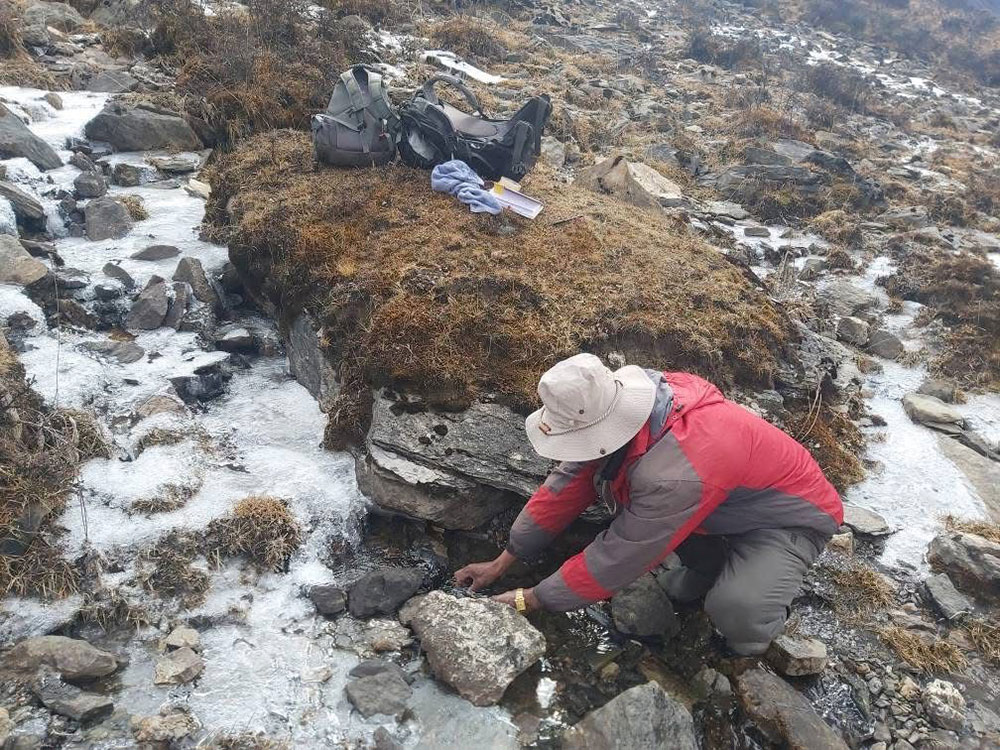The long-term mission of the study is to integrate data into climate change research, producing projections on how evolving climatic condition impact Bhutan’s critical water supply
Yangyel Lhaden
The National Centre for Hydrology and Meteorology (NCHM) is conducting a study to identify the dominant sources contributing to surface runoff in the major river system of Thimchhu.
This is the fourth study of this kind, following similar analyses of the Chamkharchhu and Pachhu rivers. Data collected for the Mochhu river is currently being processed, with results expected by June.
For this study, water samples are collected from all contributing sources of the river, such as groundwater, tributaries, snow, and glaciers, across all seasons.
So far, the NHCM team has collected samples from two seasons. Two more samples from the next two seasons will be collected before they are sent to India for analysis.
“Scientific information on seasonal variations from these different sources will help us understand the status of water resources in the country,” the chief of the Cryosphere Services Division, Karma said. “Understanding these processes is crucial for assessing the vulnerability of water supplies for downstream populations, particularly in the context of a changing climate.”
The long-term mission of the study is to integrate this data into climate change research, producing projections on how evolving climatic conditions—including glacier and snow melt—impact Bhutan’s critical water supply.
Previous studies on the Chamkharchhu and Pachhu have revealed that glaciers are a significant source of water for these two river systems.
The study on the Chamkharchhu, conducted by lecturers from Sherubtse College between 2014 and 2017, found that glacier ice meltwater contributed 23 percent and snowmelt 39 percent to the river’s flow during the pre-monsoon season.
A subsequent study on the Pachhu, conducted by NCHM and Sherubtse College in 2019–2020, identified glacier ice melt and groundwater as dominant contributors, with glaciers accounting for an average of 49.6 percent of the flow.
The reliance on glaciers as a dominant water source raises concerns about water security. The glaciers in Asia are often referred to as the “water tower” because they store vast amounts of ice and gradually release meltwater, feeding major river systems.
A recent publication by the International Centre for Integrated Mountain Development (ICIMOD), the Snow Update Report 2024, indicates a 20 percent decline in snow cover in the Hindu Kush Himalaya (HKH) region between November 2023 and April 2024. This is the lowest snow cover recorded in the past two decades, significantly impacting water security for millions in the HKH region and billions downstream.
As part of the HKH, Bhutan is also directly affected by these changes.
The NCHM study findings will inform the government on water resource management and climate adaptation strategies, and policymaking to ensure sustainable water supplies and mitigate the impacts of climate change.
Globally, similar studies have provided governments with crucial, data-backed insights. For instance, research on the Colorado River in the United States has informed water rights allocations, dam management, and drought planning, ensuring equitable water distribution and environmental sustainability.
This project is supported by the Green Climate Fund (GCF) Readiness Fund. GCF Readiness Fund, is a funding mechanism designed to help developing countries enhance their capacity to access, manage, and implement GCF projects. GCF supports a wide range of projects aimed at helping developing countries mitigate and adapt to the impacts of climate change.


